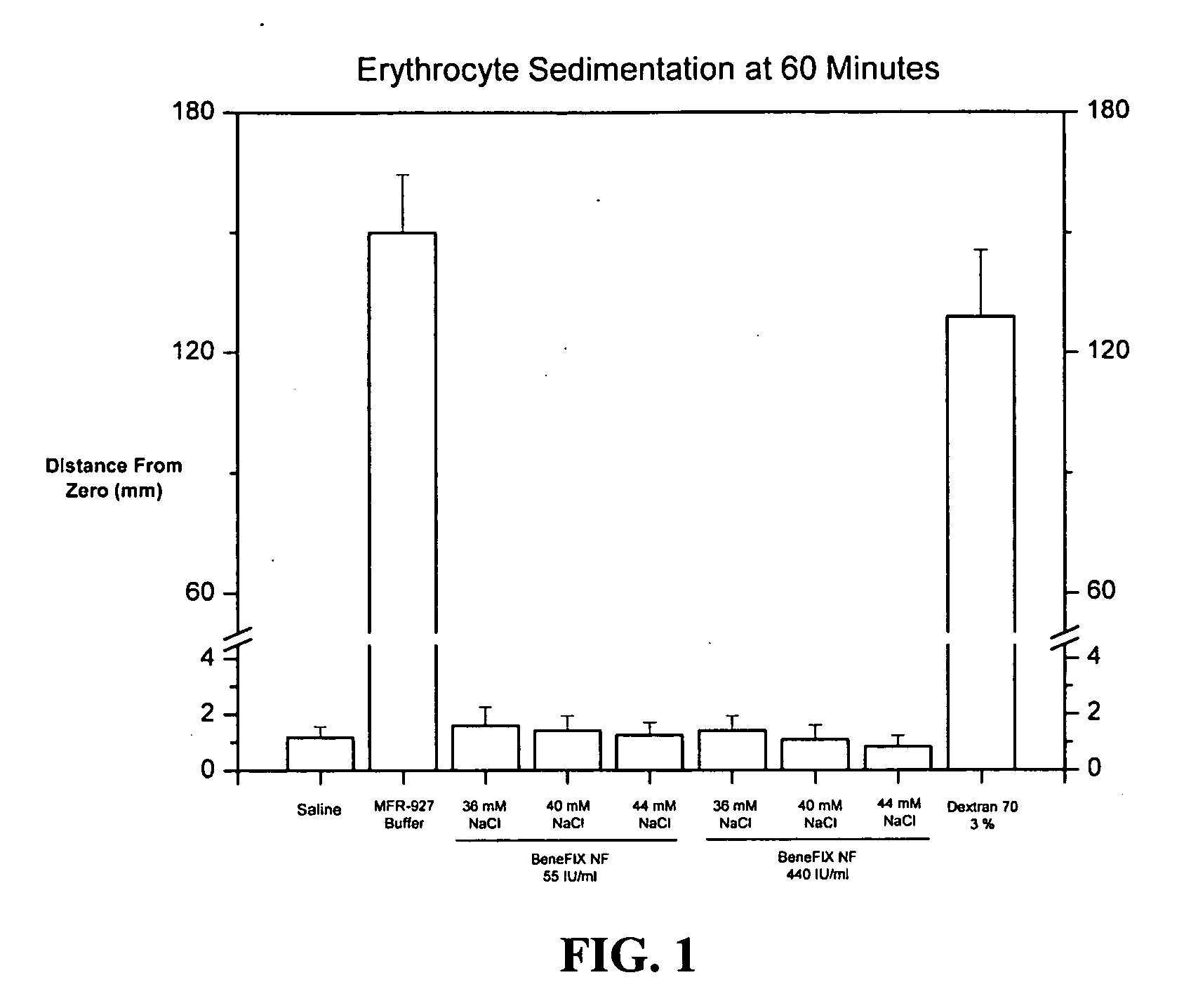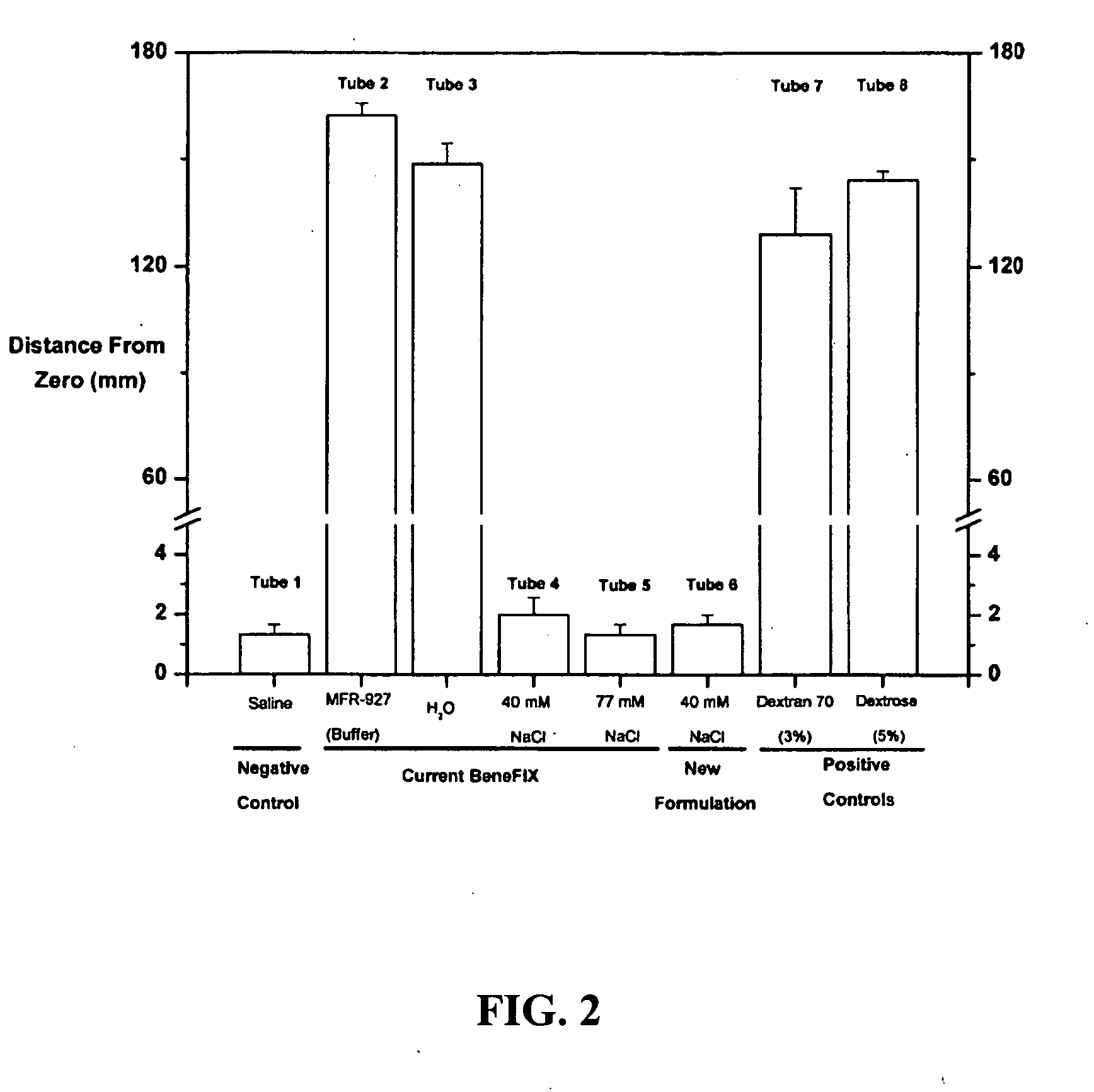Sodium chloride solution for drug reconstitution or dilution
a technology of sodium chloride and drug, applied in the direction of peptide/protein ingredients, inorganic non-active ingredients, extracellular fluid disorder, etc., can solve the problems of reducing dehydration of red blood cells (rbcs), and/or possibly thrombosis, so as to maintain the isotonicity, reduce the volume of the formulation to be injected, and maintain the isotonic
- Summary
- Abstract
- Description
- Claims
- Application Information
AI Technical Summary
Benefits of technology
Problems solved by technology
Method used
Image
Examples
example 1
Effects of Anti-Coagulants and Formulation Components on BeneFIX®-Associated RBC Agglutination
[0087] There are occasional reports of BeneFIX®-associated RBC agglutination in butterfly catheter lines and syringes. Recent studies in blood from hemophilia dogs demonstrate that the agglutination occurs in the absence of recombinant human FIX in the formulation buffer. Thus, the present study investigated whether standard anti-coagulants, various BeneFIX® components, and ionic strength affects the BeneFIX®-associated agglutination phenomenon.
[0088] Blood was obtained from a pool of anonymous human volunteers and was collected into Vacutainer tubes (Becton Dickinson, Franklin Lakes, N.J.) containing a standard anti-coagulant, such as ethylenediamine tetra-acetic acid (EDTA), sodium citrate, or heparin.
[0089] To test for agglutination, the blood samples in the Vacutainer tubes were first continuously mixed on a nutator. Blood, 12.5 μL, was diluted in 87.5 μL of a test solution in a 48-w...
example 2
Adaptation of the Modified Westergren Method of Erythrocyte Sedimentation Rate Measurement to Assess Erythrocyte Aggregation Induced by Pharmaceutical Agents or Formulations
[0099] The currently marketed BeneFIX® formulation is a non-ionic formulation. During administration of the BeneFIX® formulation reconstituted in sWFI, there has been infrequent observations of erythrocyte aggregation (i.e., agglutination) when a patient's blood is mixed with the reconstituted BeneFIX®, such as in intravenous tubing. The invention provides the discovery that erythrocyte aggregation is associated with the formulation, not rFIX, and is prevented by using diluents that contain at least about 40 mM NaCl. To assist in the design of custom diluents containing at least about 40 mM NaCl, a quantifiable assay was designed that can be used to measure erythrocyte sedimentation, which is an established method to assess erythrocyte aggregation in vitro. The modified Westergren method, in which blood is dilut...
example 3
Adequacy of 40 mM NaCl in Diluent for Reformulated BeneFIX® to Ameliorate Formulation-Associated Erythrocyte Aggregation
[0105] The non-ionic formulation of currently marketed BeneFIX® has been associated with in vitro erythrocyte aggregation, which can occur during administration when patient blood is mixed with BeneFIX® in intravenous tubing. The invention provides the discovery that erythrocyte aggregation is associated with the formulation, not recombinant Factor IX, and aggregation can be prevented by reconstituting BeneFIX® with diluents that contain at least 40 mM NaCl.
[0106] A goal of this Example is to test the robustness of a 40 mM diluent for reconstituting reformulated BeneFIX® (BeneFIX®-R) preparations. Specifically, experiments were designed to determine whether NaCl concentrations that deviate from 40 mM by as much as 10% are sufficient to prevent formulation-associated erythrocyte aggregation, which was assessed by the adapted, modified Westergren method to measure ...
PUM
| Property | Measurement | Unit |
|---|---|---|
| conductivity | aaaaa | aaaaa |
| conductivity | aaaaa | aaaaa |
| volume | aaaaa | aaaaa |
Abstract
Description
Claims
Application Information
 Login to View More
Login to View More - R&D
- Intellectual Property
- Life Sciences
- Materials
- Tech Scout
- Unparalleled Data Quality
- Higher Quality Content
- 60% Fewer Hallucinations
Browse by: Latest US Patents, China's latest patents, Technical Efficacy Thesaurus, Application Domain, Technology Topic, Popular Technical Reports.
© 2025 PatSnap. All rights reserved.Legal|Privacy policy|Modern Slavery Act Transparency Statement|Sitemap|About US| Contact US: help@patsnap.com


